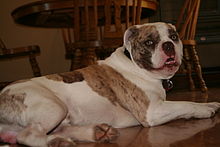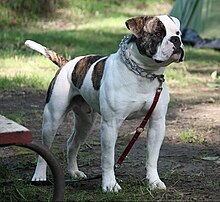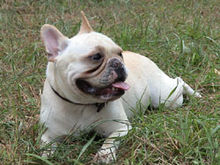| Revision as of 08:28, 8 August 2019 editNormal Op (talk | contribs)Extended confirmed users7,816 edits Added to the lede. Added a few lists of breeds. (I recommend deleting the breed summaries below the lists.)← Previous edit | Revision as of 09:00, 8 August 2019 edit undoNormal Op (talk | contribs)Extended confirmed users7,816 edits Re-added 'Bulldogge Brasileiro' material since it was recently put on this page as the result of an Afd with result=Merge.Next edit → | ||
| Line 92: | Line 92: | ||
| The ] began as a re-creation of the ]-period "bull-baiter", and was developed by David Leavitt of ] in the 1970s. The Olde English Bulldogge is a muscular, medium-sized dog of great strength, stability and athleticism. It is well-balanced and well-proportioned, with no exaggerated features. It has the appearance of a dog capable of doing its original job of bull-baiting. A selection from the Olde English Bulldogge breed is recognized by the ] as of January 2014. David Leavitt continues to develop the original breed under the name of the Leavitt Bulldog. | The ] began as a re-creation of the ]-period "bull-baiter", and was developed by David Leavitt of ] in the 1970s. The Olde English Bulldogge is a muscular, medium-sized dog of great strength, stability and athleticism. It is well-balanced and well-proportioned, with no exaggerated features. It has the appearance of a dog capable of doing its original job of bull-baiting. A selection from the Olde English Bulldogge breed is recognized by the ] as of January 2014. David Leavitt continues to develop the original breed under the name of the Leavitt Bulldog. | ||
| {{Clear}} | {{Clear}} | ||
| ==Rare breeds== | |||
| ===Bulldogge Brasileiro=== | |||
| ] | |||
| The Bulldogge Brasileiro (''Brazilian Bulldogge''), also known as the Bullbras, is a bulldog-type dog breed from ].<ref name="ReferenceA">''* {{pt}} '']'' magazine, Brazil: ], 2010, monthly, Edition nº 379, ISSN 1413-3040, special report: novas raças brasileiras (new brazilian dog breeds)</ref> The breed is recognized by the SONARB (National Society of Brazilian Breeds: a minor kennel club from Brazil) since 2013.<ref> {{pt icon}}</ref> In March 2006, the dog breeder Wagmar de Souza began to crossbred some breeds including the ], ], ], ] and other breeds<ref name="ReferenceA" /> to create a new ] retaining the anatomical features of the common bulldog-type dogs, while avoiding the health impairments such as respiratory ailments, low physical resistance and ].<ref name="ReferenceA"/> By 2010, a little more than 50 dogs were considered Bullbras.<ref name="ReferenceA" /> They are in the possession of Souza and his project partners Sérgio Infante (of ]), Geraldo Starling and Fernando Starling (both from ]). The Bullbras weighs between 28 and 38 kg, and 43 to 50 cm in height. Their coat colors are uncommon in other bulldog-type breeds, featuring uniform chocolate coat, blue or black with a white mark under belly. They sometimes have tan marks.<ref name="ReferenceA" /> | |||
| ==References== | ==References== | ||
Revision as of 09:00, 8 August 2019
| An editor has nominated this article for deletion. You are welcome to participate in the deletion discussion, which will decide whether or not to retain it.Feel free to improve the article, but do not remove this notice before the discussion is closed. For more information, see the guide to deletion. Find sources: "Bulldog type" – news · newspapers · books · scholar · JSTOR%5B%5BWikipedia%3AArticles+for+deletion%2FBulldog+breeds%5D%5DAFD |
| This article needs additional citations for verification. Please help improve this article by adding citations to reliable sources. Unsourced material may be challenged and removed. Find sources: "Bulldog type" – news · newspapers · books · scholar · JSTOR (April 2016) (Learn how and when to remove this message) |

Bulldog breeds, also known as bull breeds, is a collective name for various dog breeds of a particular type. Historically, bulldog breeds originate from the fighting dog and molossian breeds. They typically have a stocky square build, a large head and mouth, strong jaws, and a shortened muzzle. Several of the bulldog breeds are brachycephalic which brings several health risks.
The smaller bulldog breeds are sometimes called "endearing and adorable" and have consistently ranked high in popularity. In the USA the AKC ranked the French Bulldog in 4th place and the Bulldog in 5th place of most popular dog breeds in 2017. In the UK the Kennel Club named the French Bulldog as the nation’s favorite dog breed, outranking the Labrador Retriever for the first time since 1990, and in 2016 the English bulldog made the top 10 list in several parts of the kingdom.

Breeds with 'bulldog' in the name
The following dog breeds have variations of "bulldog" in the name.
- Alapaha Blue Blood Bulldog
- American Bulldog
- Bulldog
- Bulldogge Brasileiro
- Campeiro Bulldog
- Catahoula bulldog
- French Bulldog
- Old English Bulldog (Extinct)
- Olde English Bulldogge
- Serrano Bulldog
- Spanish Bulldog
- Toy Bulldog (Extinct)
Breeds with 'bull' in the name
The following breeds have variants of "bull" in the name, indicating either they are a shortened variant of 'bulldog' or the breed has a bull-baiting background or the dogs have bull-type appearances.
- American Bully
- American Pit Bull Terrier
- Bull and Terrier (Extinct)
- Bull Terrier
- Bullenbeisser (Extinct)
- Bullmastiff
- Bully Kutta
- Miniature Bull Terrier
- Pit bull
- Staffordshire Bull Terrier
Breeds without 'bull' in their name
The following are breeds that are considered of the bull-type but do not have 'bull' in the name.
Extinct breeds
Bullenbeisser

The Bullenbeisser was a breed from Germany known for its strength and agility. The American Boxer Club (ABC), which is the official breed club recognized by the American Kennel Club (AKC), believes it "is generally accepted that a smaller Bullenbeisser bred in Brabant, an area in Northeast Belgium, is a direct ancestor of today's Boxer"; however, the information is anecdotal. The AKC also acknowledged the Boxer's history as "...thought to have been bred down by German dog fanciers from a larger, heavier German breed called the Bullenbeisser (“bull biter”)." The ABC further describes the Bullenbeisser as being three types:
- The heavy Bullenbeisser (Mastiff).
- The large hound evolved by crossing the Bullenbeisser with the old type Wolf or Deerhound (The Great Dane).
- The small Bullenbeisser which represents a smaller form of the heavy Bullenbeisser through natural selection (The Boxer and the English Bulldog)."
The primary reference used by the ABC for the breed's ancestry is the book "The Boxer" (1939) authored by John P. Wagner. Wagner stated "...numerous crosses with the Bullenbeisser resulted in an eventual similarity of type that made it very difficult to distinguish where any degree of Bulldog blood was present except that white color began to appear in the Boxers."
Old English Bulldog
The first historical traces of bull-baiting occur in the time of the regency of King John. Enraged steers, specially bred for their aggressive nature, were used to test the keenness of dogs. A collar around the bull's neck was fastened to a thick rope about three to five metres long, attached to a hook, then fastened to an embedded stake that turned, allowing the bull to watch its antagonizer.

The dog's goal in the attack was to pin and steadfastly hold on to the bull's nose, which is its most sensitive spot. If the dog gripped tightly, the bull became completely tractable. The practical purpose that predated the sport was that the working "butcher's dogs" rendered the semi-wild cattle available to the butcher for slaughter without human injury. To avoid this attack, experienced fighting bulls lowered their heads as much as possible in the direction of the attacking dog, protecting their noses and meeting the attacker with only their horns, tossing the dog into the air. The dog reciprocated by staying low to the ground as it crept towards the bull. These tactics resulted in a specialized breed in the form of the now-extinct original Old English Bulldog.
This breed was extremely compact, broad and muscular. Modern oral history describes a particular characteristic of the breed as a lower jaw that projected considerably in front of the upper jaw, which made possible the strong, vice-like grip. This is highly doubtful, since all modern working catch dogs have a level or reverse scissors bite. The story continues that the nose was deeply set, which allowed the dog to get enough air as it gripped the bull. A certain small amount of "layback" of the nose may possibly have been desirable, but a more important characteristic would have been a large nasal opening for airflow. The contemporary recreation of this breed of lore is called the Olde English Bulldogge.
Toy Bulldog

The Toy Bulldog, also known as the Miniature Bulldog and the English Toy Bulldog, was a small breed of bulldog that averaged 40 pounds (18 kg) in weight. Many of them were pushed out of Britain during the mid- to late 19th century, seen as a threat to the Bulldog, and were extinct by the early 20th century. It was the ancestor of the modern French Bulldog.
Recognized breeds
Alapaha Blue Blood Bulldog

The Alapaha Blue Blood Bulldog was developed around the 1800s in the Alapaha River region of Georgia. It was created as an attempt to re-create the extinct Plantation Dog. It is descended from the Old English Bulldog and was developed as a family and property guard dog. It is larger in size than the Bulldog.
American Bulldog

Like the Alapaha Blue Blood Bulldog, the American Bulldog is also larger in size than the Bulldog. There are historically considered to be two types of American Bulldog, the Johnson type (also known as the Classic or Bully type) and the Scott type (also known as the Standard or Performance type), named after the breeders who were influential in developing them, John D. Johnson and Allen Scott, respectively. Most current American Bulldogs have ancestry from both lineages.
Bulldog

The Bulldog of today has developed greatly since the initial bull-baiting days, inasmuch as characteristics of the breed (such as the underbite, size of the head and width of shoulder) have been accentuated by selective breeding. The term "Bulldog" is the correct name for the breed, although it is often commonly referred to as either the "English Bulldog" or the "British Bulldog".
French Bulldog

The French Bulldog emerged as Bulldogs that were crossbred with Toy Bulldogs by the artistic community in Paris. They average 10 to 12 kilograms (22 to 26 lb). Their physical appearance is characterized by naturally occurring 'bat ears' that are pointy and stick straight up. Their tails are naturally short, not cropped. Otherwise, their body shape is similar to that of a Bulldog.
Olde English Bulldogge

The Olde English Bulldogge began as a re-creation of the British Regency-period "bull-baiter", and was developed by David Leavitt of Coatesville, Pennsylvania in the 1970s. The Olde English Bulldogge is a muscular, medium-sized dog of great strength, stability and athleticism. It is well-balanced and well-proportioned, with no exaggerated features. It has the appearance of a dog capable of doing its original job of bull-baiting. A selection from the Olde English Bulldogge breed is recognized by the United Kennel Club as of January 2014. David Leavitt continues to develop the original breed under the name of the Leavitt Bulldog.
Rare breeds
Bulldogge Brasileiro

The Bulldogge Brasileiro (Brazilian Bulldogge), also known as the Bullbras, is a bulldog-type dog breed from Brazil. The breed is recognized by the SONARB (National Society of Brazilian Breeds: a minor kennel club from Brazil) since 2013. In March 2006, the dog breeder Wagmar de Souza began to crossbred some breeds including the Olde English Bulldogge, English Bulldog, Campeiro Bulldog, Boxer and other breeds to create a new breed retaining the anatomical features of the common bulldog-type dogs, while avoiding the health impairments such as respiratory ailments, low physical resistance and hip dysplasia. By 2010, a little more than 50 dogs were considered Bullbras. They are in the possession of Souza and his project partners Sérgio Infante (of São Paulo), Geraldo Starling and Fernando Starling (both from Brasilia). The Bullbras weighs between 28 and 38 kg, and 43 to 50 cm in height. Their coat colors are uncommon in other bulldog-type breeds, featuring uniform chocolate coat, blue or black with a white mark under belly. They sometimes have tan marks.
References
- "Bulldog breeds. The different types of bulldogs". bulldogbreeds.bulldoginformation.com. Retrieved 2019-06-08.
- ^ "Bulldog Breeds - Which Make The Very Best Pets?". The Happy Puppy Site. 2018-05-21. Retrieved 2019-06-08.
- AKC staff. "America's Most Popular Dog Breeds: From #1 to #189". American Kennel Club.
- Jowaheer, Roshina (June 19, 2018). "The Labrador is no longer Britain's favourite dog – this little pup has taken over". Country Living.
- "Britain's top dog breed is announced". February 24, 2017 – via www.telegraph.co.uk.
- "American Boxer Club: Short History of the Boxer Breed". American Boxer Club. 1912-09-28. Retrieved 2019-08-06.
- "Boxer Dog Breed Information". American Kennel Club. 2017-11-06. Retrieved 2019-08-06.
- "The Boxer - Complete Information on the History, Development, Characteristics, Breeding, Feeding, Care and Management: John P. Wagner: 9781446509708". Retrieved 2019-08-06.
- ^ * Template:Pt Cães & Cia magazine, Brazil: Editora Forix, 2010, monthly, Edition nº 379, ISSN 1413-3040, special report: novas raças brasileiras (new brazilian dog breeds)
- SONARB news - Bullbras recognized Template:Pt icon
- Brearley, Joan McDonald (1985). The Book of the Bulldog. Neptune, NJ: TFH Publications. ISBN 0-86622-027-5.
- Jenkins, Robert; Ken Mollett (1997). The Story of the Real Bulldog. Neptune, NJ: TFH Publications. ISBN 0-7938-0491-4.
- Zwettler, Marlene (2013). The Great Book of Bulldogs, Bull Terrier and Molosser. Amazon Digital Services. ISBN 9783844239225.